Individual heating in an apartment: the best options for an apartment building
Few apartment owners in a high-rise building are completely satisfied with central heating. Uncomfortable temperature, interruptions in the supply of heat and hot water, dampness and fungus in the premises. And most importantly, the high cost of utilities, the quality of which often leaves much to be desired. Do you agree?
There is an effective method of combating the listed negativity - this is individual heating in the apartment. We will talk about options for organizing it and ways to bring the idea to life. The article we presented describes in detail the schemes using various types of fuel, and describes the features of the arrangement.
The content of the article:
Autonomous heating in an apartment: is it possible?
The desire to install autonomous heating is quite understandable. Calculations show that the cost of heating housing and supplying hot water should be significantly reduced. According to statistics, on average, they are reduced by two to three times for heating and four to five times for heating water.
The result is a significant amount. It is clear that you will have to spend money on installing equipment, on its maintenance and on purchasing energy resources, but the costs will be justified.
The utility industry is not at all interested in losing consumers of its services. Therefore, you need to be prepared for the fact that you will have to make efforts to implement your plans.First of all, you need to know exactly what the legislation says about autonomous heating in an apartment.
Very often, the apartment owner is denied disconnection from the central heating supply, citing Federal Law No. 190 “On Heat Supply”. However, this is unlawful, since there is Government Decree No. 307, which was issued on April 16, 2012. It prescribes the procedure for connecting autonomous heating systems in apartment buildings.
There is also a list of heat sources that are strictly prohibited for installing autonomous heating in such houses. Therefore, it is allowed to install individual heating provided that modern safe equipment is used.
You must understand that before purchasing and installing equipment, you need to obtain permission to disconnect from the centralized system and permission to switch to individual heating of the selected type.
To do this, you will have to collect a significant package of documents and wait for a decision to be made. Only after this can you begin to rebuild the heating.
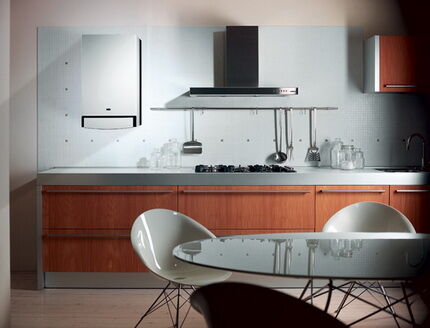
Features of individual apartment heating
When planning to switch to autonomous heating, you need to realistically assess your capabilities and understand that most of the options that are quite acceptable for private houses are impossible in a high-rise building. You should immediately “sweep away” solid fuel and liquid fuel boilers of all types.
This is due to the fact that their uninterrupted operation requires a supply of fuel, which is unsafe in an apartment building.
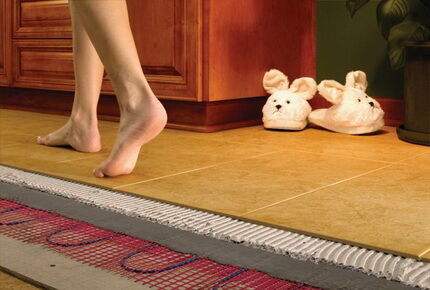
In addition, it is also extremely inconvenient. In this case, it is also prohibited to use a warm water floor. It is only possible to install one of its electrical varieties.
You need to know that when arranging individual heating in a high-rise building, you will have to take into account not only your own interests, but also the interests of other residents who may be dissatisfied with some of the difficulties arising as a result of your actions.
Therefore, choosing the right heat source is very important. This is an important stage that actually determines the success of the planned event.
Despite the limitations, there are still many options for autonomous systems. First of all, this is gas-fired heating. Moreover, you need to take into account that we are not talking about bottled fuel, but about connecting to the gas main.
The option with cylinders is not even worth considering, since it will cost much more than central heating, and is extremely inconvenient. Heating using mains gas is very economical and can operate completely autonomously.
The best source of heat for one of the apartments in a high-rise building will be wall-mounted double-circuit boiler with thermostat and electronic ignition. It will automatically maintain the most comfortable temperature and supply hot water.
If there is enough free space in the apartment, you should pay attention to a boiler with a boiler.This will stabilize the supply of hot water.
Electric heating can also be installed in apartment buildings. It can be implemented in several options, when electricity is used for direct heating, which is more expensive, or indirect.
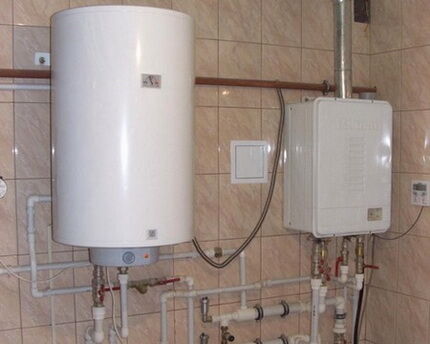
An electrically powered system may have a boiler or a heat pump as a heat source, and an electric cable floor as an energy transmitter. infrared film, baseboard radiators or electric convectors.
The apartment owner can choose any suitable option or combine several. For example, heated floors and convectors. Let us consider in detail each of the possible methods of arranging autonomous heating.
Gas heating in the apartment
Such a system represents a closed circuit with coolant circulating inside. A gas-fired boiler is used to heat the liquid. It can be single or double circuit. It all depends on the needs of the people living in the apartment. As you know, gas boilers can be floor-mounted or wall-mounted. For apartments, the second option is chosen.
These are compact, but at the same time quite powerful devices. For an apartment, you should choose a heating device with a closed burner. Such devices do not take air from the room and do not require a traditional chimney system.
The latter is not always possible in an apartment building. Boilers with turbocharging require a special type of chimney, which is quite easy to install.
What benefits does the owner of gas heating receive? First of all, it ceases to depend on the timing of the heating season. The boiler is ready for use at any time and can be started as needed.
The cost of fuel is relatively low. Compared to heating with electricity, for example, operating a boiler will cost much less. In addition, if you install thermostatic valves for batteries and purchase a heating unit with automatic control, you will be able to save on its operation.
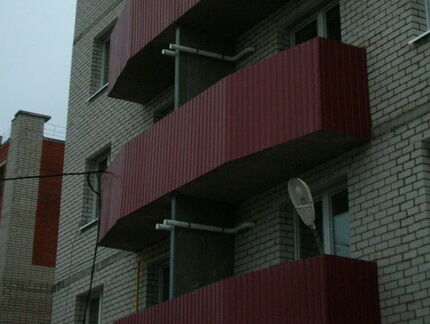
This is explained by the fact that the automation will regulate the temperature in the rooms, selecting the most economical operating mode and turning off the equipment when the set temperature is reached. It will not be possible to do this “manually” even if you want to.
The advantages include the compactness of gas heating equipment, its high efficiency and quite affordable cost. The solution also has disadvantages. The most obvious are related to the potential dangers posed by gas heating.
The owner of the apartment will be required to obtain a package of permits for installation of gas equipment. However, you need to understand that it will be received only if the apartment fully complies with safety requirements. The purchased equipment must be certified.
Installation, connection and subsequent maintenance should only be carried out by specialists.In general, gas equipment should be handled extremely carefully and no amateur activity, be it a self-made part for the boiler or self-repair of the device, is unacceptable here.
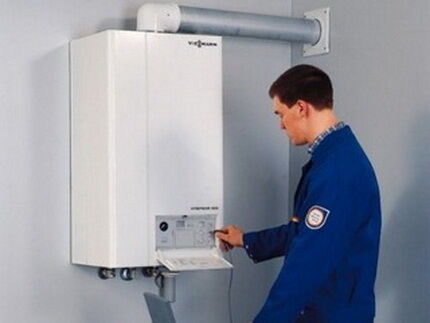
Disadvantages include the energy dependence of the system, which will not work without electricity. Despite the shortcomings, practice shows that gas heating is becoming the most common choice among apartment owners.
It allows you to get maximum cost savings and at the same time get efficient heating of your home. The possibility of parallel arrangement of hot water supply makes this solution even more attractive.
Electric heating direct heating
The concept of direct heating assumes that electrical energy will be directly converted into heat. There are several options for such systems acceptable for apartments.
Using convectors or radiators
Electrically powered radiators are simple converter devices. Two electrodes are lowered into an electrolyte, which is mineral oil. Current flowing through the liquid heats it up. Considering that the boiling point of the oil is high and its heat dissipation is very good, the surface of the radiator heats up in a short time.
To increase the heat transfer of the device, its body is usually made ribbed. The device can be controlled manually, for this purpose a special regulator can be installed on the body, or automatically, which is only possible for programmable models.
The advantage of this heating method can be considered the extreme simplicity of arrangement. Oil radiators are simply placed in the required areas. It is important that they have access to electricity.
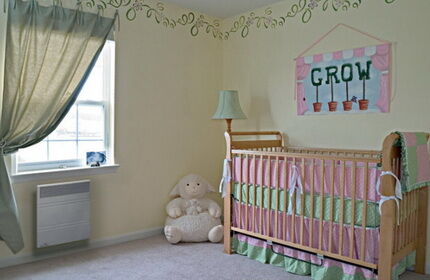
Nothing else is needed. The devices heat up quickly, but take a long time to cool down. They operate completely silently and do not emit toxic substances. The devices are compact and have an attractive design.
The main disadvantage of electric radiators is their high energy consumption, which is very disadvantageous for their owners. Electric convectors are considered a good alternative to radiators.
Their difference lies in the fact that the heating elements installed in the devices heat the air entering the housing, which subsequently rises up and enters the heated room. Convectors are available in wall-mounted and floor-mounted versions, which is very convenient for their placement in a room.
The advantages of the devices are approximately the same as those of radiators. The only thing is that they consume electricity more economically, but they still use quite a lot of it.
Heated floor system
She represents electric heating system, consisting of special heating mats or cables laid in the floor. When turned on, the devices convert electricity into heat, which is radiated from the entire surface of the floor.
This is a big plus, since the room warms up as evenly as possible. The temperature difference between the lower and upper parts of the room is minimal.

The system has built-in sensors that monitor the room temperature. As soon as it reaches a predetermined level, the heating is automatically turned off and vice versa, when the temperature drops, the heating is turned on.
Thus, the system independently maintains the desired temperature. It is possible to implement different scenarios, that is, some rooms may be warmer, others – cooler.
Warm floors do not dry out the air, humidity remains at a comfortable level. They are absolutely harmless to those living in the apartment. The system makes it possible to warm up rooms as quickly as possible.
They are quite easy to install and can be laid on almost any base. Warm floors do not take up free space or spoil the interior, since there are simply no bulky radiators and pipes.
The service life of the system is half a century or more. Let's talk about the disadvantages of heated floors. They are more economical than radiators and convectors, but still consume electricity.
And its consumption is quite large. It largely depends on the degree of insulation of the apartment, the desired heating temperature and other factors, so there are ways to save. Often such systems are used as additional heating.
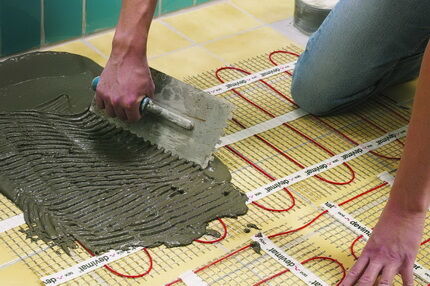
However, in a small well-insulated apartment it will work perfectly as the main one.The disadvantages include the rather high price of the equipment and its installation. You need to know that according to the rules, heating mats or cables can only be laid in a screed. In addition, most likely, you will also need to replace the old unreliable wiring, and this is also expensive.
Infrared heating options
This type of individual heating in an apartment building is based on the use of infrared radiation. Infrared heating systems They are surfaces assembled from a special film, laid on the floor or mounted on the ceiling.
In any case, an effective result will be obtained. When current passes through graphite paste deposited on such a film, infrared radiation appears. The rays move until they encounter a massive obstacle on the way. This could be the floor, ceiling or large pieces of furniture. Here they linger and begin to accumulate in the object that detained them.
Thus, the floor or furniture heats up and releases the previously received heat into the air, causing the temperature in the room to rise very quickly. The main advantage of infrared heating is the temperature distribution that is most comfortable for humans.

Wherever the infrared film is placed, on the ceiling or on the floor, the bottom of the room will always be warmer than the top. It is this distribution, according to doctors, that is ideal for human health.
By their nature, infrared rays are similar to thermal solar radiation, therefore they are completely safe for the body and even beneficial. This type of heating system is fully automated.
It must have built-in sensors that monitor the temperature in the room. Based on their readings, the controller turns the system off/on.
Thanks to this, the heating always operates in the most efficient energy-saving mode. Considering that the film warms up the room very quickly, such a heater does not remain in working condition for very long, approximately 10-15% of the total operating time.
Thus, IR films can be recognized as the most effective and economical. In addition, their use does not spoil the indoor microclimate. Air humidity remains unchanged. Question about harm or benefit of infrared heating discussed in the article, which we advise you to read.
Such heaters do not make noise, do not emit toxic substances and are completely invisible in the interior. The film is installed under the floor or ceiling covering, which does not affect its performance characteristics.
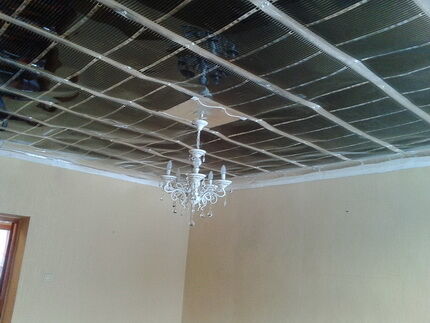
There are also infrared heaters, ceiling and floor types. But they are used exclusively for heating a specific area. IR films can be used for additional or main heating of an apartment.
Among the disadvantages, it is worth noting the high price of the equipment, as well as the need to carry out accurate calculations when arranging such a heating system. Otherwise, the costs of its maintenance may be prohibitively high.
Water electric heating
It is a standard closed heating circuit, where the coolant is heated by an electric boiler. This is very effective because the liquid heats up quickly.
The efficiency of such a system is determined by the type of boiler used. The most common heating element option is the simplest in design and operation.
They sink into the liquid and, when activated, quickly heat it up. The efficiency of such devices is relatively low and they consume a large amount of energy. The most vulnerable point of such devices is heating elements. They interact with coolant and quickly fail.
A more reliable option is an electrode boiler. The coolant is pumped through the body of the device, inside of which there are electrodes.
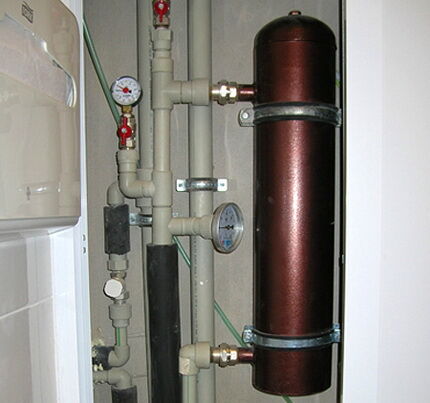
When current passes, the liquid quickly heats up. The peculiarity of using such a boiler is the need for additional preparation of the coolant. Electrode devices are durable and reliable. In terms of energy consumption, they are approximately equivalent to heating elements. The third option for electric boilers is induction. These are the most economical modern devices.
The equipment has two circuits - heat exchange and magnetic, due to which temperature redistribution occurs and the liquid heats up as quickly as possible. The efficiency of such devices is very high. The devices are compact and easy to use. Among the disadvantages, it is worth noting the high cost of induction-type boilers and the difficulty in making their adjustments.
Electric heating indirect heating
In this case we are talking about heat pumps of various types. Electricity will only be used to operate equipment that extracts heat from the environment. Therefore, its consumption is relatively small.
It must be noted that the use of heat pumps is optimal only in areas with a mild climate, where winter temperatures are quite mild and there is no frost.
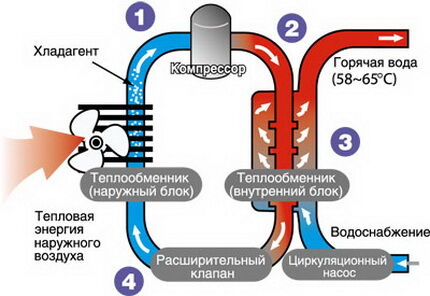
The best options for heating an apartment are air-to-air or air-to-water pumps. The former are similar in principle to air conditioners, so they can be used in summer to cool air masses indoors.
To obtain heat, you will need to purchase and install expensive equipment, but in the future the heat pump will pay off. A unit of heat obtained in this way costs approximately the same as that obtained using a gas boiler.
Conclusions and useful video on the topic
Video #1. Advantages of using autonomous heating in an apartment:
Video #2. Advantages and disadvantages of individual gas heating:
Video #3. How to install electric heating in your apartment:
Autonomous heating of an apartment is a reasonable and practical solution that allows you to save significant amounts on heating your home. It is important to choose the right heat source for the apartment and correctly calculate the heating system.
In this case, problems with operation should not arise and the owner can only rejoice in the warmth and his independence from the centralized system.
Would you like to share your own experience in organizing individual heating of a city apartment? Do you have information on a topic that would be useful to site visitors? Please write comments in the block below, ask questions, post photographs.




I live in the corner entrance of an apartment building, on the top floor, where the central heating was extremely poor. The apartment was constantly cold, so I decided to disconnect from the central heating system and install individual heating. The most difficult thing was to collect a package of documents and get permission. Difficult, troublesome, long and dreary! But I collected it. Initially I wanted to install a mounted gas boiler on two circuits (heating and hot water), as it was the most efficient and easiest to operate. In the kitchen I had to sacrifice space on the wall for the boiler, then redo the entire heating system, cut myself off from the lower apartment, changed the radiators, installed aluminum ones instead of cast iron ones, and new pipes. The boiler was installed and connected by a specialist from the office, they took the boiler under warranty, everything is serious. But when I turned on the boiler for the first time, and after 5 minutes all the radiators in the apartment became hot - I can’t put it into words, it was worth it! And they have already forgotten how to pay exorbitant bills for heating, which never really existed.
To be honest, I don’t see a situation in our country where completely autonomous heating in an apartment might be needed. It’s one thing when we’re talking about an additional function, like a heated floor on the ground floor, but quite another when we’re talking about a completely independent system.It is doubtful that this can be economically profitable, but it is certain that you will need to collect a bunch of papers and permits.
I have a problem with heating, but under no circumstances am I allowed to do something individually. They install so many pom-poms... starting with Gorgaz, then Management Company, then heating networks, and the last office is the city administration. In short, a vicious circle. And some crap sits in the offices. How to deal with them?
I am in the process of preparing documents to disconnect from the central heating. package of documents: minutes of the in-person meeting, register of residents of the mkd. letter to the general director of the management company. I passed all this with great difficulty. Accepted the third time. Waiting for an answer. I'll post information as I progress.
I don’t know about anyone, he himself has individual heating, there are no downsides, it’s been installed since 2010, in an apartment building, it’s very profitable - in terms of finances, paying for gas and electricity, for example, if you compare paying for gas in the summer - when the boiler doesn’t work - heating with in winter, then paying for gas in winter is 2 times more, but even then it is very profitable, from the disadvantages of individual heating - there will be no blackouts of light and heat, I have a baxi main 24 i gas boiler, so as not to deceive, its approximate price is time was 30 - 35 thousand rubles for the boiler itself, for heating I paid around 2 thousand, this is taking into account my benefits, that is, it turns out that in three years I justified my boiler, if you decide to install individual heating and they give you permission, advice - approach it wisely choosing the boiler itself. Good luck to everyone in making your dreams come true